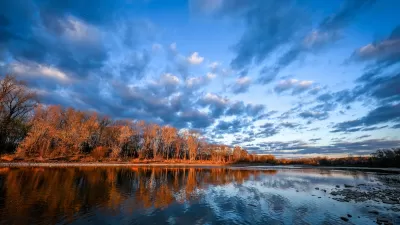A study of U.S. waterways shows that around half of lakes, rivers, and streams in the U.S. are too toxic to swim or fish in.

A report from the Environmental Integrity Project reveals that around half of U.S. rivers and lakes are too polluted to swim or fish in, reports Theo Whitcomb in High Country News—this despite the 1972 Clean Water Act's ten-year target of making all of the nation's waters safe and accessible.
"The Clean Water Act delivered a major win — it laid the groundwork for essential enforcement on industry — but there were key failures. Most notably, legal loopholes continue to allow fertilizer runoff from farmland and manure runoff from factory farms." According to the article, "While rivers and lakes have significantly improved in the 50 years since the legislation passed, the fight to make sure all waters are safe continues." The study is based on an analysis of 27 percent of U.S. river and stream miles.
The report names California as first in the nation for river and stream miles too polluted for drinking. It would take 700 years "to achieve full restoration of currently impaired waterbodies under current pace of remediation, according to an EPA report from 2011."
Environmental advocates say lawmakers will once again have to put in the work that got the Clean Water Act passed in the first place to boost protections and create more effective regulations for cropland, a top cause of pollution that Environmental Integrity Project executive director Eric Shaeffer called the program's single biggest failure.
FULL STORY: Report: Over half of U.S. waters are too polluted to swim or fish

Alabama: Trump Terminates Settlements for Black Communities Harmed By Raw Sewage
Trump deemed the landmark civil rights agreement “illegal DEI and environmental justice policy.”

Study: Maui’s Plan to Convert Vacation Rentals to Long-Term Housing Could Cause Nearly $1 Billion Economic Loss
The plan would reduce visitor accommodation by 25% resulting in 1,900 jobs lost.

Planetizen Federal Action Tracker
A weekly monitor of how Trump’s orders and actions are impacting planners and planning in America.

Waymo Gets Permission to Map SF’s Market Street
If allowed to operate on the traffic-restricted street, Waymo’s autonomous taxis would have a leg up over ride-hailing competitors — and counter the city’s efforts to grow bike and pedestrian on the thoroughfare.

Parklet Symposium Highlights the Success of Shared Spaces
Parklets got a boost during the Covid-19 pandemic, when the concept was translated to outdoor dining programs that offered restaurants a lifeline during the shutdown.

Federal Homelessness Agency Places Entire Staff on Leave
The U.S. Interagency Council on Homelessness is the only federal agency dedicated to preventing and ending homelessness.
Urban Design for Planners 1: Software Tools
This six-course series explores essential urban design concepts using open source software and equips planners with the tools they need to participate fully in the urban design process.
Planning for Universal Design
Learn the tools for implementing Universal Design in planning regulations.
Caltrans
Smith Gee Studio
Institute for Housing and Urban Development Studies (IHS)
City of Grandview
Harvard GSD Executive Education
Toledo-Lucas County Plan Commissions
Salt Lake City
NYU Wagner Graduate School of Public Service





























